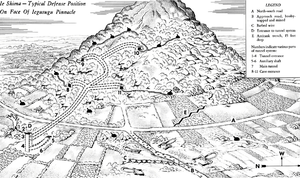Military intelligence
[1] This aim is achieved by providing an assessment of data from a range of sources, directed towards the commanders' mission requirements or responding to questions as part of operational or campaign planning.Most governments maintain a military intelligence capability to provide analytical and information collection personnel in both specialist units and from other arms and services.Strategic intelligence is concerned with broad issues such as economics, political assessments, military capabilities and intentions of foreign nations (and, increasingly, non-state actors).[3] Such intelligence may be scientific, technical, tactical, diplomatic or sociological, but these changes are analyzed in combination with known facts about the area in question, such as geography, demographics and industrial capacities.In the U.S. military, Joint Publication 2-0 (JP 2-0) states: "The six categories of intelligence operations are: planning and direction; collection; processing and exploitation; analysis and production; dissemination and integration; and evaluation and feedback."For example, the population, ethnic make-up and main industries of a region are extremely important to military commanders, and this information is usually public.Ordinary facts like the lunar phase on particular days or the ballistic range of common military weapons are also very valuable to planning, and are habitually collected in an intelligence library.For western democracies, it is extremely rare for journalists to be paid by an official intelligence service, but they may still patriotically pass on tidbits of information they gather as they carry on their legitimate business.Analysis of bulk traffic is normally performed by complex computer programs that parse natural language and phone numbers looking for threatening conversations and correspondents.For example, in modern mechanized warfare, the logistics chain for a military unit's fuel supply is often the most vulnerable part of a nation's order of battle.Critical vulnerabilities are then indexed in a way that makes them easily available to advisors and line intelligence personnel who package this information for policy-makers and war-fighters.Developing a plan of attack is not the responsibility of intelligence, though it helps an analyst to know the capabilities of common types of military units.

Defense intelligence (disambiguation)Military Intelligence (disambiguation)1st Marine Logistics GroupoutlineHistoryPrehistoricAncientPost-classicalCastlesEarly modernMilitary revolutionPike and shotNapoleonic warfareLate modernIndustrial warfareFourth-gen warfareMilitaryOrganizationCommand and controlDefense ministryAir forceMarinesCoast guardSpace forceReservesEngineersMedicalPoliceDivingInfantryCavalryArtillerySpecial forcesSignal corpsWarshipsSubmarinesAircraft carriersLanding craftAuxiliary shipsFightersBombersCommandClose air supportElectronic-warfareReconnaissanceFire-control systemFire-control radarDirector (military)Combat information centerShip gun fire-controlGun data computerTorpedo data computerBasic trainingMilitary manoeuvrersCombat trainingBattlespaceAerospaceAerialAirborneCold-regionDesertFortificationJungleMountainSubterraneanTunnelAmphibiousSurfaceUnderwaterSeabedInformationWeaponsAir defenceBarrageBiologicalCamouflageHorsesChemicalCombined armsConventionalDenialDisinformationElectromagneticLoiteringMissileNuclearPsychologicalRadiologicalSubmarineUnconventionalTacticsList of military tacticsAirliftAir assaultAirbridgeAirdropAnti-aircraftAnti-subAnti-tankBattleChargeCounterattackCounterinsurgencyConvoyDefeat in detailFoxholeEnvelopmentFormationGuerrillaRapid dominanceEncirclementInvestmentScreenTactical objectiveTarget saturationTrenchWithdrawalOperationalMilitary operationSpecialOperations researchBlitzkriegExpeditionaryDeep operationManeuverOperational manoeuvre group